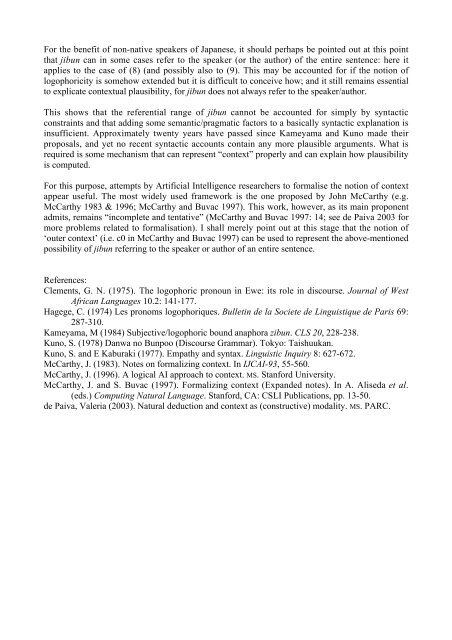SemPrag03.Progr.pdf - Institut für Linguistik/Germanistik - Universität ...
SemPrag03.Progr.pdf - Institut für Linguistik/Germanistik - Universität ...
SemPrag03.Progr.pdf - Institut für Linguistik/Germanistik - Universität ...
Create successful ePaper yourself
Turn your PDF publications into a flip-book with our unique Google optimized e-Paper software.
For the benefit of non-native speakers of Japanese, it should perhaps be pointed out at this point<br />
that jibun can in some cases refer to the speaker (or the author) of the entire sentence: here it<br />
applies to the case of (8) (and possibly also to (9). This may be accounted for if the notion of<br />
logophoricity is somehow extended but it is difficult to conceive how; and it still remains essential<br />
to explicate contextual plausibility, for jibun does not always refer to the speaker/author.<br />
This shows that the referential range of jibun cannot be accounted for simply by syntactic<br />
constraints and that adding some semantic/pragmatic factors to a basically syntactic explanation is<br />
insufficient. Approximately twenty years have passed since Kameyama and Kuno made their<br />
proposals, and yet no recent syntactic accounts contain any more plausible arguments. What is<br />
required is some mechanism that can represent “context” properly and can explain how plausibility<br />
is computed.<br />
For this purpose, attempts by Artificial Intelligence researchers to formalise the notion of context<br />
appear useful. The most widely used framework is the one proposed by John McCarthy (e.g.<br />
McCarthy 1983 & 1996; McCarthy and Buvac 1997). This work, however, as its main proponent<br />
admits, remains “incomplete and tentative” (McCarthy and Buvac 1997: 14; see de Paiva 2003 for<br />
more problems related to formalisation). I shall merely point out at this stage that the notion of<br />
‘outer context’ (i.e. c0 in McCarthy and Buvac 1997) can be used to represent the above-mentioned<br />
possibility of jibun referring to the speaker or author of an entire sentence.<br />
References:<br />
Clements, G. N. (1975). The logophoric pronoun in Ewe: its role in discourse. Journal of West<br />
African Languages 10.2: 141-177.<br />
Hagege, C. (1974) Les pronoms logophoriques. Bulletin de la Societe de Linguistique de Paris 69:<br />
287-310.<br />
Kameyama, M (1984) Subjective/logophoric bound anaphora zibun. CLS 20, 228-238.<br />
Kuno, S. (1978) Danwa no Bunpoo (Discourse Grammar). Tokyo: Taishuukan.<br />
Kuno, S. and E Kaburaki (1977). Empathy and syntax. Linguistic Inquiry 8: 627-672.<br />
McCarthy, J. (1983). Notes on formalizing context. In IJCAI-93, 55-560.<br />
McCarthy, J. (1996). A logical AI approach to context. MS. Stanford University.<br />
McCarthy, J. and S. Buvac (1997). Formalizing context (Expanded notes). In A. Aliseda et al.<br />
(eds.) Computing Natural Language. Stanford, CA: CSLI Publications, pp. 13-50.<br />
de Paiva, Valeria (2003). Natural deduction and context as (constructive) modality. MS. PARC.

















